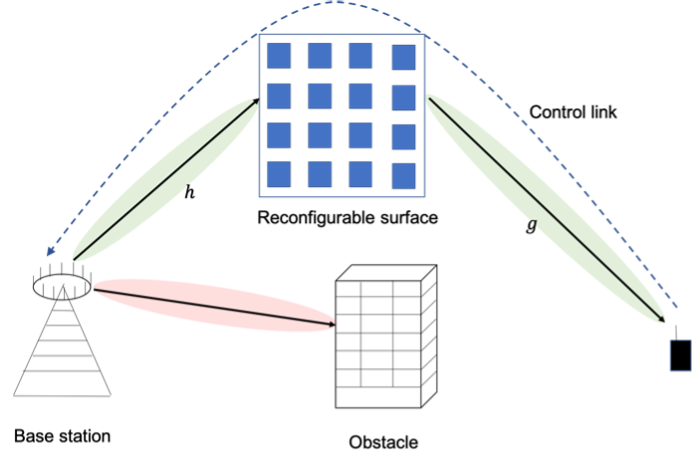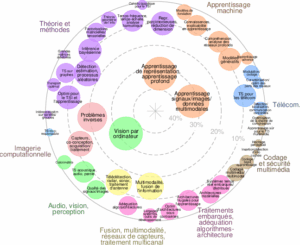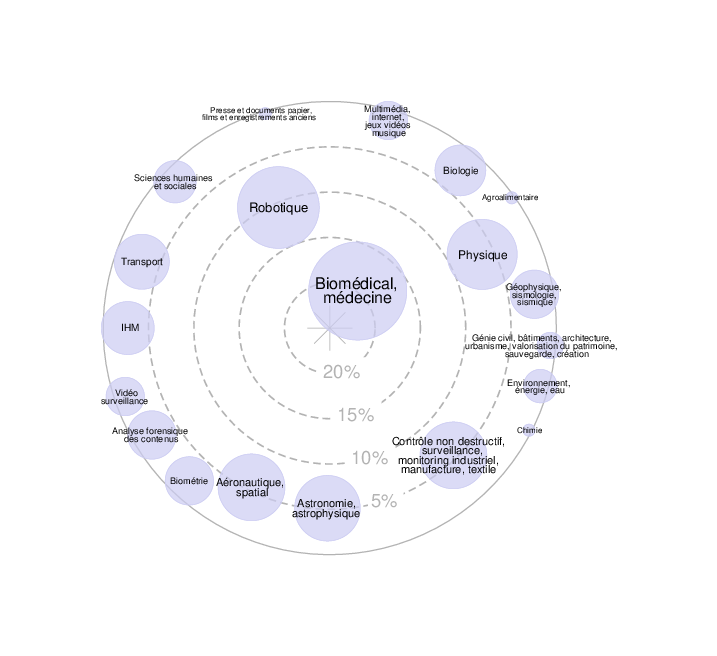This thesis work will be carried out as part of the « Sustainable, Secured, Sovereign and Intelligent Networks (RIS3) » project, at the IETR laboratory on the INSA Rennes campus. The expected starting date is October 1st, 2025.
Topic
Context and state of the art
The ever-increasing demand for bandwidth to satisfy ever more sophisticated applications continues to grow in the telecom sector, leading to exponential data consumption and rising energy bills [1]. To support this increase in data and energy consumption, a regular transition of technology is necessary, and takes place every 10 years on average. Each transition is accompanied by technological innovations, such as the reconfigurable surfaces.

Figure 1 : Communication scenario with a reconfigurable surface
The integration of reconfigurable surfaces into future wireless communication networks has attracted a great deal of academic and industrial interest in recent years [2]. These devices, incorporating small elementary radiative circuits, can be controlled to modify the phase of the incident wave to focus it on the end-user, as illustrated in Figure 1. This technology allows to control the propagation environment in the sense that multi-paths are no longer undergone but exploited. Numerous works in the literature demonstrate the potential benefits of this technology in terms of achievable throughput, user coverage and energy efficiency [3,4]. On the other hand, the control of wavefronts impacting the smart surface requires information from the end-user, to agilely change the properties of the radiating surface. The amount of data to be transmitted back to the transmitter and the reconfigurable surface will depend on the time and coherence bandwidth of the channel, as well as the number of users to be served. Few studies have addressed the information overhead involved in controlling these surfaces, except in [5,6]. The authors in [6] adopt an information-theoretic approach to propose joint « data-control » encoding to maximize end-to-end throughput. The authors show that joint encoding maximizes the achievable throughput of the system, compared to the case where phase-shifters are set to maximize the receive SNR, as usually considered in literature. However, the return link required to encode the information is not considered. Furthermore, the imperfect knowledge of the channel state and the consideration of multiple users are not considered, neither the finite block length analysis.
From an information-theoretic point of view, the point-to-point communication with reconfigurable surface problem can be modelled as in Figure 2 and has been studied in [7], in part. The author derived fundamental capacity limits (achievability and converse) when states are causally and non-causally known at the encoder. However, the fact that the capacity can be increased or not by allowing encoding states according to past actions remains an open question, for non-causal situations. Moreover, the finite block-length extension of this work is also untreated and far from being trivial.

Figure 2 : Joint Information and control encoding
The study of fundamental limits of multi-user communications with states (multiple access and broadcast channels) has received some attentions (see [8] and references therein) but the study of the joint information and control encoding for controllable environments in multi-user settings remains globally opened.
Objectives of the thesis
This thesis aims at studying the fundamental limits of communication with a reconfigurable surface and to quantify the amount of control bits needed to optimally operate these devices, in various setups, i.e. multi-antenna point-to-point communications, finite block-length regime, multiple access and broadcast channels. More precisely, we propose to tackle the following research questions:
Q1: What is the achievable rate of the configuration shown in Figure 2? We will first recover the results of literature in the asymptotic regime, and the finite block-length fundamental bounds will be tackled.
Q2: What is the tradeoff characterization between the data rate to be granted to control signals and that for encoding user information?
Q3: How to extend the previous analysis to the Gaussian multi-user cases, i.e. multiple access channel and broadcast channel?
As this technology is envisaged for deployment in 6G and future wireless communication systems, the derivation of their fundamental limits is of utmost importance to assess the performance of practical coding / signal processing schemes that may be implemented and, also, to evaluate the impact of the overhead needed to operate these devices and its impact on the energy consumption.
References
[1] Ericsson, « Ericsson Mobility Report: Resilient 5G uptake – global mobile data traffic set to triple in six years »,https://mb.cision.com/Main/15448/3884810/2463363.pdf.
[2] M. Di Renzo et al., « Smart Radio Environments Empowered by Reconfigurable Intelligent Surfaces: How It Works, State of Research, and The Road Ahead, » IEEE Journal on Selected Areas in Communications, vol. 38, no. 11, pp. 2450-2525, Nov. 2020.
[3] N. Shlezinger, et al., « Dynamic Metasurface Antennas for Uplink Massive MIMO Systems, » IEEE Transactions on Communications, vol. 67, no. 10, pp. 6829-6843, Oct. 2019.
[4] Z. Yang et al., « Energy-Efficient Wireless Communications with Distributed Reconfigurable Intelligent Surfaces, » IEEE Transactions on Wireless Communications, vol. 21, no. 1, pp. 665-679, Jan. 2022.
[5] A. Zappone, et al., « Overhead-Aware Design of Reconfigurable Intelligent Surfaces in Smart Radio Environments, » IEEE Transactions on Wireless Communications, vol. 20, no. 1, pp. 126-141.
[6] R. Karasik, et al. « Beyond max-SNR: Joint encoding for reconfigurable intelligent surfaces », In Proc. IEEE Int. Symp. Inf. Theory, 2020.
[7] T. Weissman, « Capacity of Channels With Action-Dependent States, » in IEEE Transactions on Information Theory, vol. 56, no. 11, pp. 5396-5411, Nov. 2010.[8] A. El Gamal, Y.-H. Kim, Network Information Theory, Cambridge University Press, 2011
[8] A. El Gamal, Y.-H. Kim, Network Information Theory, Cambridge University Press, 2011
Key Skills
The candidate must have earned a Master 2 or an engineering degree of a Grande Ecole in one of the following fields: information and communication theory, signal processing, applied mathematics. She or he should be comfortable with one or more of the following programming languages: Matlab, Python or C/C++. A strong spirit of curiosity and strong interest in mathematical developments are expected.
Keywords
Information theory, channels with states, probability, convex, non-convex and variational optimization, reconfigurable intelligent surfaces.
How to apply
Send an email to the people listed below, explaining your interest to the topic and why you think you have the background to address it. Please, attach the following documents:
– A CV with a complete list of projects / internships / courses related to the topic.
– Academic records from Bachelor to MSc.
– The contact of one or two referees (internship or project supervisor, teacher, etc.)
Contacts
- Philippe Mary: philippe.mary@insa-rennes.fr, https://pmary.perso.insa-rennes.fr
- Luc Le Magoarou: luc.le-magoarou@insa-rennes.fr, https://luclemagoarou.netlify.app
More details on https://www.ietr.fr/sites/www.ietr.fr/files/medias/files/phd_bounds_ris.pdf





